Here’s a question for you: what’s the first thing any visitor notices on your website? Your header? Your logo? Your headline? The answer is none of these; it’s your loading time. Before a visitor sees any of your content, they’ll watch your website load. The expectation is that this will happen almost instantaneously. If it doesn’t, they’ll start to leave and this will impact on your conversion rates. But there are other reasons why a slow loading site causes problems: it increases your bounce rate, it makes your site harder to crawl, it gives a poorer experience for your visitor and, perhaps most crucially, it lowers your ranking on search engines. In this post, we’ll look at the importance of site speed for your website.
- Google uses site speed as a ranking factor
Google’s mission to provide users with the best possible search results means it is actively demoting slow loading websites. It doesn’t consider it good business to send visitors to websites that take too long to load as it reflects badly on itself. So, even if your content is great, your ranking in search results can still suffer. And this means less traffic and fewer sales.
What’s more, this applies to searches done on mobiles as well as on computers, so if your desktop site runs fine but your mobile site is sluggish, you’re still going to rank lower. - Site speed affects search engine crawling
If you want all your content to be searchable on the internet, search engines have to discover what’s there. This is done through what is known as site crawling, where a search bot will go to your homepage and follow all the links until it has made an inventory of every page it can find. These pages and their content are then indexed so they can be searched for.
When undertaking a crawl, a search engine needs to send requests to your server to receive information about your content. However, as each request uses up a part of your server’s resources, search engines are reluctant to send too many in case they slow your website down for genuine visitors. If your loading times are slow or you have a poor server response time, then, to prevent overburdening your website, search engines will crawl fewer pages. As a result, not all your pages may get indexed or updates to existing pages may not get noticed.
This should not be a big problem for small websites, however, if you have a large website that is constantly adding new content or if you have a significant amount of older content, it could be an issue. One way to improve crawling efficiency is to improve your site structure. Delete outdated content, eradicate any broken links, put in redirects where necessary and tidy up your menus and categories. This will cut down on the amount of unnecessary crawling a search engine has to do, so it can focus on the content that counts. - Faster sites have higher conversion rates
While studies into the effects of site speed have come up with different figures, they all agree on one thing: the faster a website, the higher its conversion rates. HubSpot looked at 12 different case studies and showed that a 1 second delay in loading times reduces conversion and revenue by 7% and page views by 11%. Similar results were shown for bounce rates: the faster the loading times, the lower the rate. A page that loaded in 9.9 seconds had a 58% bounce rate, compared to 12.8% for a page that loaded in 2.4 seconds.
This goes to show that even the smallest delay can impact your bottom line. Quite simply, the longer people have to wait, the fewer of them are going to stick around all the way to the checkout. To grab those sales and remain competitive, you have to have a website that loads faster than your competitors. - A faster website equals happier users
If you want visitors to stick around until they purchase something, you have to provide them with a great experience. This is especially so if you want to retain those customers over the long term. Studies have shown that site speed is an integral part of creating a good user experience this is why Google places so much importance on it when ranking sites. The statistics for conversion rates and bounce rates back this up.
If you want to improve your brand reputation and increase customer loyalty, making your website faster should be one of the things that you consistently try to achieve.
How to improve your site speed
The first stage for anyone wanting to make their site faster is to discover its current desktop and mobile loading times and to find out where improvements need to be made. You can find this out easily by using the free Google PageSpeed Insights Tool. Just type in your URL and it will give your site marks out of 100 for its desktop and mobile loading times. The higher the mark, the better. Of more value, it will also identify the issues which are causing your loading times to be slow and provide you with a list of modifications that can make it load even quicker. These will include things such as caching, compression and image optimisation.
Another issue which can affect your loading times is the performance of your web server. This can be due to your host using slower hardware or not configuring the server for optimum speed. For those on a shared hosting plan, it can also be due to other users hogging all the server resources and your host not dealing with the matter.
Conclusion
As you can see, slow loading speeds can affect your site in all kinds of ways: lowing search engine ranking, preventing pages from being indexed, reducing conversion rates and revenue, and negatively impacting the user experience. Hopefully, the information provided here will help you check your own site speed and put measures in place to make it load faster.
If you are looking for hosting that can improve your loading times, consider upgrading from your shared hosting package to one of our affordable, high-performance VPS solutions.


